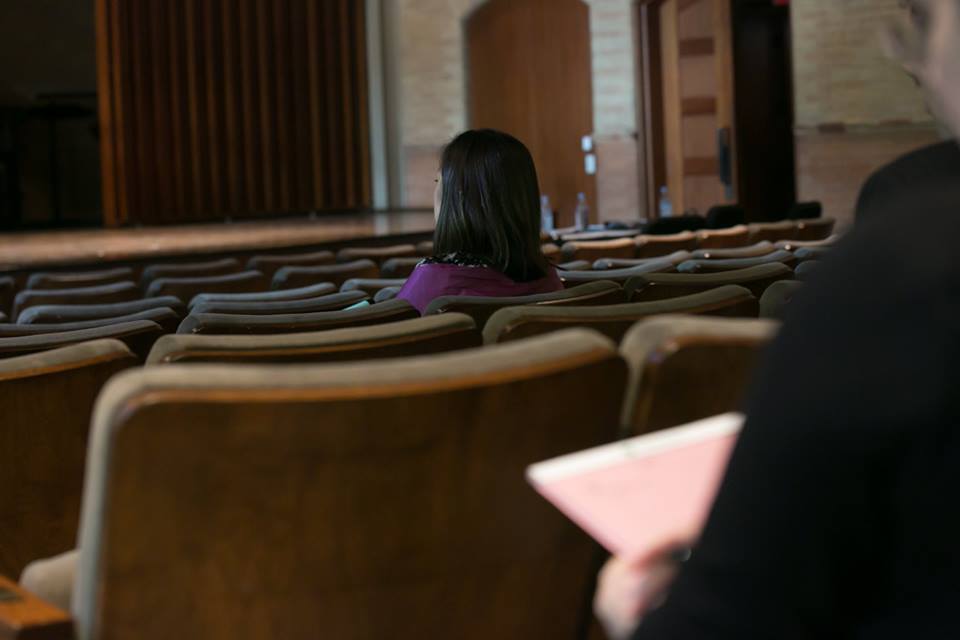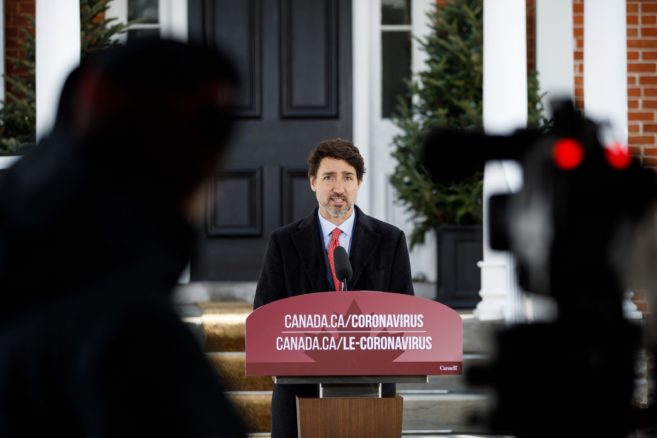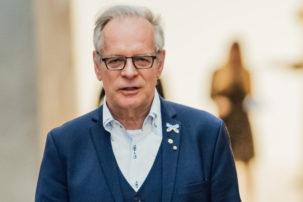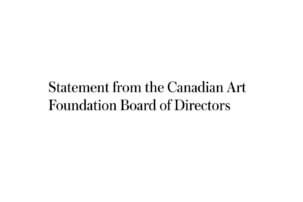The Canada Council is our nation’s largest public art funder. In 2017–18 alone, it distributed $218.9 million to artists, projects and organizations across the country.
Much of this money is distributed through a new model introduced in April 2017 that saw 147 funding programs restructured to just 6, eliminating most disciplinary boundaries. The new model is intended to help achieve council’s strategic priorities: balancing project and core funding 50-50, tripling support to Indigenous artists, organizations and communities, doubling investments in international arts support and investing 25% of new money in artists or organizations that have never received funding before.
What’s more, the influence of this model is due to grow even more as the Canada Council budget rises to $310 million by 2021.
But where could the application process for funding be improved? Who might be finding themselves concerned about specific trickle-downs of the new model, even as they support its broader aims? How much can Canada Council even out with regional arts-funding inequities?
These are some of the questions that have come to light in recent months. The Toronto Alliance for the Performing Arts contends that Montreal artists are getting way more money than Toronto artists. CARFAC National says it was surprised by a new 60% funding cap for arts service organizations. Ann Connors, a peer assessor from St. John’s, has stated that she was concerned by funding outcomes she herself had done ranking for. And at least one artist still finds the new application process destabilizing.
“This was the first time I felt as if I wasn’t able to speak to my peers,” says Svava Juliusson, a Southwestern Ontario visual artist who has successfully applied for many grants in the past but found herself stymied by the new council application language. “Overall, I think the mandate change is a positive thing, and the attempt to give people who hadn’t had opportunities before the chance to apply.” But the dance- and music-focused terminology on the application form prompted her to wonder: “Am I describing my work to someone who has no visual arts background at all? Do I have to go over the history of sculpture?”
While the Canada Council seems to be doing its best to address these kinds of problems and account for them, there still, at times, appears to be tension or miscommunication between the council and the artists or arts organizations it says it hopes to serve. And this tension or miscommunication leads to many lingering questions.
“A Montreal artist is apparently valued twice as much as a Toronto artist,” states the Toronto Alliance for the Performing Arts about Canada Council funding.
What Regions Get the Most Funding?
“[We] conducted a survey this past spring to explore the impact of the Canada Council’s new funding model and gain perspective regarding the allocation of new resources,” writes the Toronto Alliance for the Performing Arts (TAPA) in a September 2018 public letter. “Half of those surveyed with operating budgets of $500,000 or more were flatlined, while 10% of the same cohort received increases of 10% to 30%.”
In a follow-up public letter in March 2019, TAPA argued “there is a marked difference between Canada Council grants to Montreal and Toronto. It added: “A Montreal artist is apparently valued twice as much as a Toronto artist,” with TAPA calculating council funding per Montreal artist at $4,259.32 in 2017–18 and council funding per Toronto artist at $1,915.24 in the same period.
TAPA says it made these calculations by taking the total amount of Canada Council funding provided to recipients in a given city, then divided that total by what recent census data indicates is the number of artists living in that city.
The Canada Council calculates per-artist distribution differently, looking at average grant received by individual artists in each city. In the council’s calculations, Toronto artists in 2017–18 received an average grant of $14,070, while Montreal-based artists in the same year received an average grant of $15,056—a difference of 7% rather than 100%.
Council reps are also careful to point out that their funds are allotted based on applications received—not on the number of artists in the labour force, nor on a per-capita metric.
April Britski is executive director at CARFAC National, a Canada-wide group that acts as the national voice of Canada’s professional visual artists. Britski is aware of the Canada Council’s mandate and process—and also says that she, too, has heard concerns from members and from other organizations about the importance of Canada Council funding following provincial arts funding cuts or holds. In recent months, the Government of Ontario cut millions from the Ontario Arts Council budget, including funds specifically aimed at supporting Indigenous communities. Just a few days ago, that government also slashed the Ontario Music Fund by half. The election of similarly hardline Conservative government in Alberta also doesn’t bode well for arts funding there.
“It’s not our role to be equalize systemic differences in funding in all the different ecosystems throughout the country,” says a Canada Council rep.
“I understand the ideal is to have as diverse a funding stream as possible,” says Britski, “but you can’t always count on all those other funding models, because you never know when something may be completely cut outside of your control…. You might be an amazing organization, but if the province decides to cut its arts council by 20% then that affects you as well.”
Canada Council representatives said they understand worries about provincial arts funding—but that it can only do so much. “We understand those concerns, and we work with our provincial counterparts,” says Carolyn Warren, director general of Arts Granting Programs at the Canada Council, in an interview. “The thing with the Canada Council is that it’s not our role to be equalize systemic differences in funding which we find in all the different ecosystems throughout the country.”
Again, Canada Council staff note they are trying to do more outreach across the country in terms of applications and information workshops—the hope is to generate more successful funding applications from all regions of Canada.
“Our system is driven by demand and it is competitive—and it relies on assessments or organizations by their peers,” says Warren. “Which is a complete different system than saying, ‘we have regional envelopes, and we can give more to, say, Ontario or B.C. as different ecosystems experience different funding pressures.’”
“There are many factors that go into how much money you get—including how much money you have asked for,” says the Canada Council in addressing funding questions.
Who Assesses and Decides on Funding?
As described in the introduction to this article, a shift to more interdisciplinary arts applications at the Canada Council is welcomed by many—but the language on the form has given some visual-arts specialists pause.
And once artists get past the application process, there is also the question of assessment and how that translates (or doesn’t) into funding—something St. John’s theatre presenter Ann Connors recently raised in the Globe and Mail.
Connors herself was recently a peer assessor for a round of council applications, but told the Globe she was surprised when she saw the actual funding results. “[I was] really satisfied with the rankings,” Connors told the Globe. “But when I saw the results posted later, the people who were one, two and three in the order didn’t get the highest amount of money. The one that got the most was probably seventh or eighth. So when council suggests that it is all driven by peer assessment, that’s a little disingenuous.”
“We only had one year’s warning that a new funding cap was coming,” says a CARFAC National rep. “That’s a really huge change for a lot of organizations.”
When asked about these stumbling blocks in the application and assessment process, Canada Council representatives told Canadian Art that resources are available to help applicants and assessors—but they aren’t always used or accessed.
“Council’s allocation process is detailed on our website—how peer assessment works, how funding assessments are made,” says Lise Ann Johnson, director of Granting Program Operations at the Canada Council. “We do have that detailed information. But we realized that some peer assessors are feeling the loops aren’t closed when they leave.”
As a result, Johnson says, the Canada Council will be highlighting more information to peer assessors before, during and after the assessment process about the way Council funding has been allocated.
“The order you are ranked on does not determine the amount of money you receive,” says Johnson. “And this is not new. There are many factors that go into how much money you get—including how much money you have asked for. It is absolutely normal that an applicant who is ranked number one and asked for $10,000 will get $10,000—and thus get less than the person who ranked 20th and asked for $100,000.”
Likewise, Johnson says, she wants artists who are having problems with the application forms to reach out to staff—or to use the technical assistance functions within application forms. “Even if someone does not have the ability to apply online, or they are living in a region where there is not great internet access, we do have a policy that allows other kinds of applicants to apply offline,” says Johnson.
“The cap is new, but the principle behind it is not new,” says a Canada Council rep. “In our previous funding models, diversification of your budget would have been a criteria.”
Why Were Certain Funding Programs Capped or Pulled?
Another concern Canadian Art has heard, amid generally broad support for the Canada Council’s new strategies, is a concern about the capping or cancelling of some funding programs in recent years.
Toronto artist Geoffrey James, for instance, was sad to see the old international residencies program go. Under that program, Canadian artists could be granted access to specific council-owned or council-rented studios in London, Paris and other large cities.
The new Canada Council funding model opened up international residency funding to be more flexible, providing monies towards a variety of global locales—and let go of those Council-specific studios in the process.
But James wonders why Council couldn’t have done both: kept the existing bricks-and-mortar studio spaces, and added more funds for more flexible residency travel support around the world. “It changed some people’s lives, you know,” James says of the old international residency program. “I got the Paris studio in 2000, and I got a book out of it—a book that won a $50,000 prize. So it was a very fruitful three months.”
James says that he is supportive of a lot of what Council is doing, but not elimination of those residencies. “Some of the things the Council is doing, I really applaud,” says James, “especially things that bring in new artists, and young artists—that’s great. But other changes seem very opaque.”
April Britski, executive director at CARFAC National, also says she is concerned about the newly introduced cap on funding for arts service organizations. The limit is now for such organization to be funded at 60% of budget.
“We only had one year’s warning that this [cap] was coming,” says Britski, “and that’s a really huge change for a lot of organizations….. Arts service organizations don’t qualify as much for regional and municipal funding as arts presenters do.”
“Some of the things the Council is doing, I really applaud,” says one artist. “Especially things that bring in new artists, and young artists—that’s great. But other changes seem very opaque.”
The fact that this cap is coming during a period when the Canada Council’s budget is being doubled by the feds makes matters even more confusing for arts service organizations, says Britski. “You wouldn’t think that people would be facing the possibility of a cut when there’s so much more money available,” says Britski. “I feel like a lot of organizations [as a result] are just burning themselves out chasing after project grants.”
Britski says arts service organizations’ abilities to advocate for members and art-makers is also hindered, somewhat, by the Canada Council no longer releasing information about art genre alongside grant results. “The good news is that artists who have more multidisciplinary practice are much more successful now—I do understand why they took out the disciplines,” says Britski. “But it’s really hard to know now if funding levels for visual artists have changed—that’s a significant loss of publicly available data.”
For its part, the Canada Council indicates that it is trying to balance a variety of goals and practices the best it can. “The cap is new, but the principle behind it is not new,” says Lise Ann Johnson, director of Granting Program Operations at the Canada Council. “In our previous funding models, diversification of your budget would have been a criteria that you were assessed on.”
“The principle is that we should not be funding 100% of an organization’s budget, because that’s is a very unhealthy sign for an organization,” says Carolyn Warren, Director General of Granting programs. “And the 60% cap [for arts service organizations] is actually much higher than the cap we have on other kinds of operating-funded organizations, which vary from 25% and up.”
As to the shift in artist travel program strategy, a council spokesperson notes flexibility is now key. “Just because the program has expired doesn’t mean the opportunities have,” says an email from the council. “Rather, they have just been redirected to another part of the funding structure.”
What’s to Come?
Overall, in speaking with art-sector stakeholder and Canada Council representatives, there are many points of commonality—and still many points of concern and difference.
But one thing that was made clear is that just because Council’s budget is being doubled by 2021 doesn’t mean that everyone gets their particular funding wish.
“Could we have decided that the budget increase would have gone to the 10% of organizations receiving core funding? Sure,” says Lise Ann Johnson. “But that’s not the most strategic way to ensure council is investing in a healthy ecosystem and arts sector. Caps [and limits] are important because there are other commitments council has made.”
“I also have to say that even though we have a doubling of the budget,” says Carolyn Warren, “it would take a lot more than that to fix systemic [regional] imbalances which have grown over years and years of different funding stories and priorities from province to province to province.”
Another thing that is for sure, given the breadth and depth of what Council and artists do is that talk will continue. Whether at upcoming Canada Council grant-info sessions across the nation, or over emails and phone calls, there is more conversation yet to come, as usual, about our nation’s most prominent arts funder and how it works in disbursing hundreds of millions in monies per year.
Clarifications and a correction were made to this article on May 2, 2019. An update was also made on May 17, 2019. The original copy listed Svava Juliusson as a Hamilton artist; Juliusson actually lives in Haldimand County, Southwestern Ontario. Paragraph breaks were also tightened up for clarity. And in terms of an update, more information was added about the Canada Council’s own artist-grant averages, as well as differences between that calculation and those provided by TAPA.

 The Canada Council is Canada's largest public arts funder—and some still have questions about its new strategies. Photo: Facebook / Canada Council.
The Canada Council is Canada's largest public arts funder—and some still have questions about its new strategies. Photo: Facebook / Canada Council.







